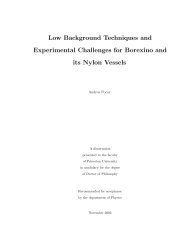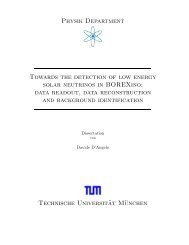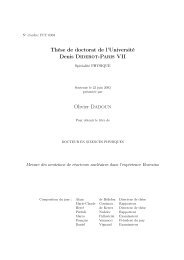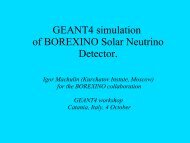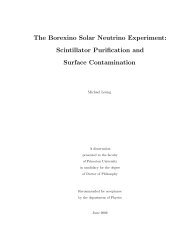Development of a Liquid Scintillator and of Data ... - Borexino - Infn
Development of a Liquid Scintillator and of Data ... - Borexino - Infn
Development of a Liquid Scintillator and of Data ... - Borexino - Infn
Create successful ePaper yourself
Turn your PDF publications into a flip-book with our unique Google optimized e-Paper software.
4 Position Reconstruction <strong>of</strong> Scintillation Events<br />
The scintillator decay time was measured in laboratory experiments for excitation by alpha<br />
<strong>and</strong> beta particles (see table 4.1 <strong>and</strong> also fig. 5.2). The emission spectrum <strong>of</strong> the BOREXINO<br />
scintillator is shown in fig. 4.1.<br />
particle excitation (ns) (ns) (ns) (ns) Õ Õ Õ Õ<br />
¬ <strong>and</strong> 3.57 17.61 59.50 - 0.895 0.063 0.042 -<br />
« 3.25 13.49 59.95 279.1 0.63 0.178 0.119 0.073<br />
Table 4.1: The decay times <strong>and</strong> the relative quantities <strong>of</strong> the decay components <strong>of</strong> the liquid<br />
scintillator È ÈÈÇ Ð .<br />
Absorption <strong>and</strong> Light Scattering<br />
The attenuation length for È ÈÈÇ Ð <strong>and</strong> for pure PC was obtained by measuring<br />
the absorption <strong>of</strong> a monochromatic light beam propagating along the x direction using a<br />
spectrometer <strong>and</strong> defining £ according to<br />
Á Ü Á Ü£ <br />
As shown in figure 4.2, interaction with the fluor is the most probable process for photons having<br />
wavelengths shorter than about 370 nm while photons with higher wavelengths preferably<br />
interact with the solvent. The photons absorbed by the fluor are reemitted isotropically with a<br />
48<br />
Figure 4.2: Attenuation length <strong>of</strong> PC <strong>and</strong> ÈÈÇ Ð , calculated from the measured extinction<br />
coefficients [Ali00].



